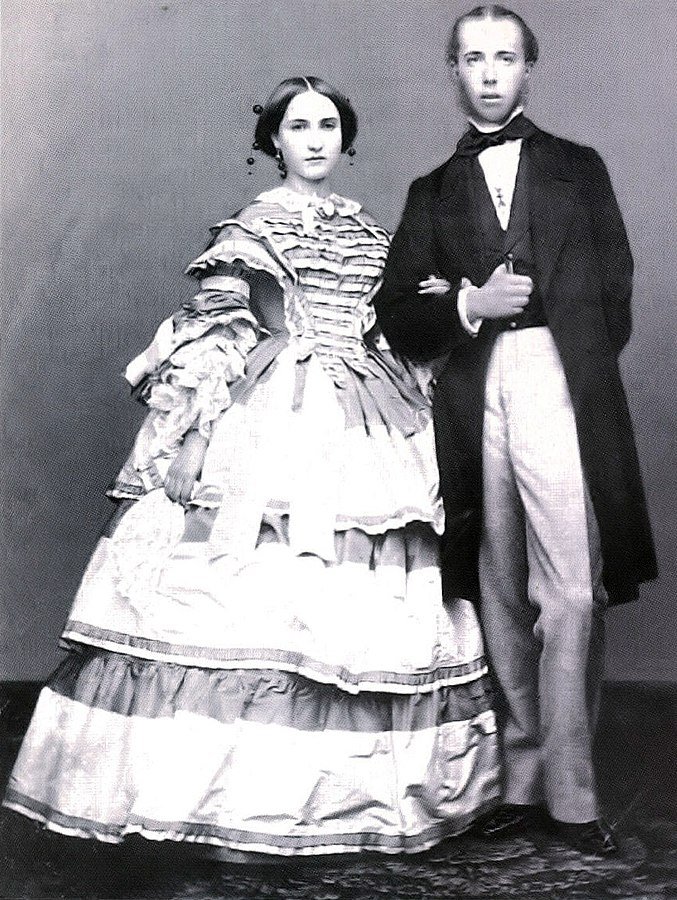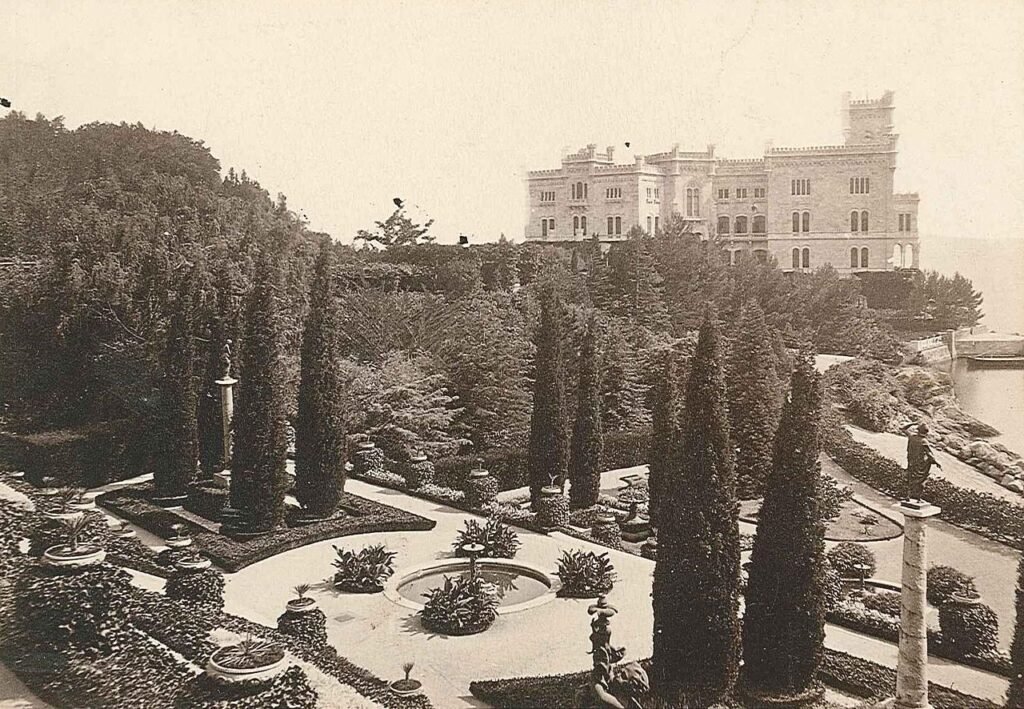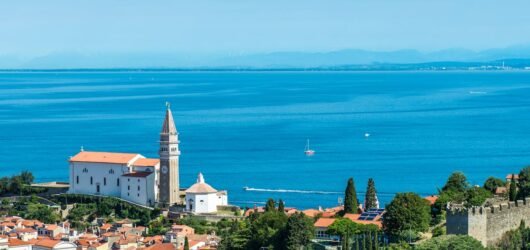It starts with weather. It usually does, around Trieste. Somewhere around 1850, a storm tore through the Gulf — rain sideways, sea all teeth and noise. A young Archduke, Ferdinand Maximilian, ducked into Grignano’s harbor to wait it out. Eighteen, proud, dripping wet, he looked up at that battered strip of limestone and thought — yes. Here. This is it.
Not a castle yet, just an idea clinging to rock and wind.

He came back. Bought the land. Called it Miramare — “look at the sea.” A name that sounds like a sigh, or a command. Maybe he stole it from a royal villa in Portugal; maybe it just drifted into his head one night.
From Rock to White Stone
By 1856, Maximilian had climbed to Commander-in-Chief of the Austrian Navy — which sounds majestic, though honestly the fleet spent more time quarreling with the weather than fighting anyone. Still, he had money, ambition, and a certain mania for perfection.
He hired Carl Junker, an engineer who didn’t worship symmetry. The result: a white puzzle of towers and terraces, Gothic flirting with Renaissance, maybe a bit of medieval costume thrown in for drama. Junker built it from Istrian stone — that creamy rock that glows by moonlight and refuses to fade.
They moved in on Christmas Eve, 1860. The place was unfinished, of course. Maximilian kept tinkering, polishing, fussing. The sort of man who’d move a window an inch to “balance the view.”
A Love Story, Then a Tragedy
Charlotte of Belgium arrived in his life a few years earlier — brilliant, sharp-tongued, almost too clever for her century. Together, they made the castle breathe. She planned gardens, chose fabrics, imported plants from wherever they wandered. You can feel her still in the rooms — something softer beneath the imperial swagger.
But then came Mexico. 1864. Bad advice, worse timing. Maximilian went chasing crowns across the ocean; Charlotte followed, loyal to the point of destruction. Three years later he was shot by firing squad, and she came home broken — mind fractured, body wandering through silence.
That’s when the whispers started. Miramare was cursed, they said. Stay overnight and something will break — fortune, sanity, marriage. Superstition, maybe. But try walking through the halls alone at dusk and tell me it doesn’t breathe.

Rooms That Remember
Inside, everything feels caught between sea and empire. Maximilian’s study is a sailor’s dream — dark wood, brass, maps spilling across the walls. He modeled it after the admiral’s cabin of his beloved ship, the Novara. That vessel carried him around the world, through scientific expeditions, through glory and delusion — and later, heartbreak. The Novara even brought his body home from Mexico.
Charlotte’s music room faces the gulf. You imagine her there, the piano barely audible over the waves.
Upstairs, the décor shifts — imperial showrooms with Japanese motifs, a Throne Room that seems embarrassed by its own grandeur. The light moves differently through the place, as if the stone itself resents sitting still.
The Garden That Shouldn’t Exist
Twenty-two hectares of stubborn, salty rock — and somehow, Maximilian made it bloom. He imported soil, gardeners, entire ecosystems. Cedars from Lebanon, cypresses from Mexico (a grim joke, in hindsight), Mediterranean olives, plants that smelled like faraway ports. The paths twist like unfinished thoughts.
If you walk slow, you can smell half the world.
The Habsburgs, the Savoia, and a Long Pause
After Maximilian’s death and Charlotte’s collapse, Miramare didn’t go quiet exactly — it just lingered. The Habsburgs came and went. Empress Elisabeth — Sissi, all beauty and melancholy — stayed here several times, her shadow still in the corridors.
Then came a new flag. After World War I, Trieste became Italian, and the castle got a new resident: Prince Amedeo, Duke of Aosta. 1931 to 1937 — six years of modernization. He installed telephones, central heating, an elevator (which still works, somehow). The Domus magazine even praised his rationalist redesign — stripped-down, military, almost cold. Savoy crosses replaced imperial eagles. The place looked less like a royal nest and more like an officer’s headquarters.
Amedeo left for Ethiopia, became Viceroy, and died in British captivity in 1941. Miramare just watched, silent.
War Moves In
The war years turned the castle upside down. 1943 — German forces took over, turned it into an officers’ school, carted off furniture to warehouses. Then the Allies came: New Zealanders, British, Americans. Between 1947 and 1954, U.S. soldiers of the TRUST mission (Trieste United States Troops) used Miramare as headquarters, trying to keep the peace in a city dangling between Italy and Yugoslavia. Imagine those uniforms in the Throne Room, ashtrays on Maximilian’s desk, radios buzzing where Charlotte once practiced piano.
History folds weirdly here.
Becoming a Museum
When Trieste officially rejoined Italy in 1954, Miramare finally belonged to the state again. The superintendents went to work — photos, sketches, restoration after restoration — dragging furniture back from wherever it had been scattered.
By June 1955, the park reopened, and the Museo Storico del Castello di Miramare was born. It smelled of varnish and salt. The dream had become a museum piece.
Now, the castle lives in its third or fourth lifetime. It’s a state museum, since 2016 operating with its own autonomy, managing other sites across Friuli Venezia Giulia — Aquileia, Cividale, Grado. A small empire of memory, curated from the ruins of a much bigger one.
Visiting — Or Listening
If you go, skip the guidebook for a while. Walk the park first, early morning if you can — mist still on the cedars, gulls screaming like something half-human.
Inside, let silence fill the gaps. The rooms echo in strange ways. Sometimes it sounds like the sea. Sometimes it sounds like the past, pacing.
Stand on the terrace and look out. You’ll understand what Maximilian saw that day — a kingdom that never quite existed, built from wind and white stone. And maybe, just maybe, worth the heartbreak.
Blog Posts

How to Get to Miramare Castle from Trieste
If you’re in Trieste and want to see Miramare Castle, here’s what actually works (you can click on this link…

Miramare Castle Tickets
Buying tickets for Miramare Castle should be simple, but somehow I still second-guessed myself while doing it. Maybe it’s…

